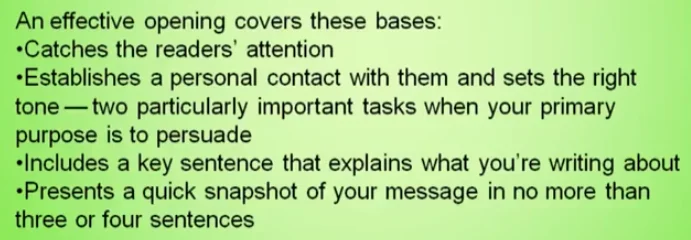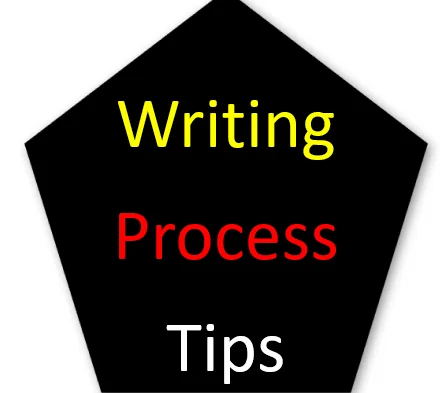Planning the Writing Process
Let’s start with the writing process of our first draft. We’ve already walked through an important step of the process of communicating which is the planning. That we need to do to identify our reader, their interests, our purpose for writing, our most important message, and the organization. That we’ll adopt for our message once we’ve done that planning process. Then we’re ready to write the first draft.

So, the first thing that we’re going to do is think about the way we create an opening. As mentioned earlier, readers like skimming and scanning. Many of us are overwhelmed by different forms of communication, email, social media, phone messages, and in-person meetings. We want to make sure that we’ve taken full advantage of our opening to get our readers’ attention.
Criteria to Write an Inviting Opening
So, what are some criteria for an inviting opening, we want to cover these bases.
- It does catch the reader’s attention.
- It establishes personal contact with them.
- And, it sets the right tone.
Those are two particularly important tasks when your purpose is to persuade. Right, if you’re just giving information, you may not need that personal connection.
But, if you’re selling anything either internally or externally in your organization, you want to make sure that you have personal contact with that person. And, you’ve set the right tone, your opening includes a key sentence that explains what you’re writing about. And, it presents a quick snapshot of your message in no more than two or three maybe four sentences.
Examples of Writing Process Versions
Version 1
This is about your recent email which was passed to this Department for review. Unfortunately, the information you requested is not yet available.
Version 2
Thank you for asking about the August 5th class. We don’t know the location of the instructors’ names. But we should be able to send you the class information or the details by July 15th.
So, what’s the difference between version 1 and version 2? Does it meet our criteria?
I thank you = is a nice way to set a great engaging tone. It also makes personal contact because it says in version 2 = thank you for asking about the August 5th class.
All right, so version 1 also says = about your recent email, but version 2 is giving a much more = personable tone. And, then it’s saying we don’t yet know. So, there’s a lot here in this second version around language and the way we use language to set the tone. But, going back to the criteria, we want to make sure that we have always included the main idea for writing. And, if appropriate, made a connection. So, if you have no better idea = thank you, is a great way to start a message.
I thank people all the time, I thank them for their time, thank them for their email, thank them for meeting with me, and thank them for the phone call. So, if there’s something that you can thank people for it’s always a great way to spend. to start your message that way.
How to avoid Overused Terms in Writing Process
So, when you’re writing an inviting opening avoid some of these overused terms. Especially, when working with local government municipalities, and different kinds of public agencies. Because we want to avoid overused phrases like = per your request, enclosed herewith.
Instead, use simple and direct language, as you asked. As a prelude here, I want to tell you that clear, simple, direct language is a great way to start your message. Your reader will hear wow this is a person that I want to communicate with. So, use an inviting opening with simple, clear, and to the point language.
Sentence and Paragraph Length
How long should a paragraph sentence be, any sentence can be about 25 words long. Sometimes, we see long dense sentences, we also see long dense paragraphs all the time. But research shows that long dense paragraphs are the most difficult way to communicate information to people. Instead, use short sentences and short paragraphs. People always ask that can a sentence, a paragraph be one sentence long. Yes, it can a paragraph can be one sentence long again. Limit your sentence and paragraph length so make sure you put your key sentence at the beginning, your most important point.
Using Lists instead of Paragraphs
Using lists instead of paragraphs, it’s a great way to communicate information. Write shorter sentences, this is a key fact that’s important to consider when you’re writing for any kind of social media platform. A long sentence is not going to work.
Use of Main Headings in the Writing Process
We oftentimes think of headings as a tool that we use for written documents, reports, and proposals. Because we can also use headings in email. So, we need to use whatever strategies we can to break up long dense texts. A visual snapshot when we see numbers or generally looking for some other kinds of breakdown shows your analytical skills by breaking down the messages.
How many of you think that this is easier to read follow this procedure to be reimbursed? So, we talked a lot about procedures we have a whole course focused on reports, proposals, and procedures. And, in it, we break down a process for writing procedures but basically, you want to make sure that all of your procedures are easy to follow.
This one is much easier to read than a procedure embedded in narrative form. So, choose one that’s broken down again. Because long dense paragraphs are not the right way to communicate a process or procedure. We started this conversation around openings and now we’re going into closings.
Closing of your Writing
A closing is another opportunity that you want to take advantage of. So, when you’re writing a closing, make final personal contact with the reader again crucial. When you’re writing to persuade, wrap up any loose ends and tell readers what happens next. And, use specific language oftentimes. Then, seize the opportunity to restate your most important point and to set the tone that we want to do business and are paying attention.

